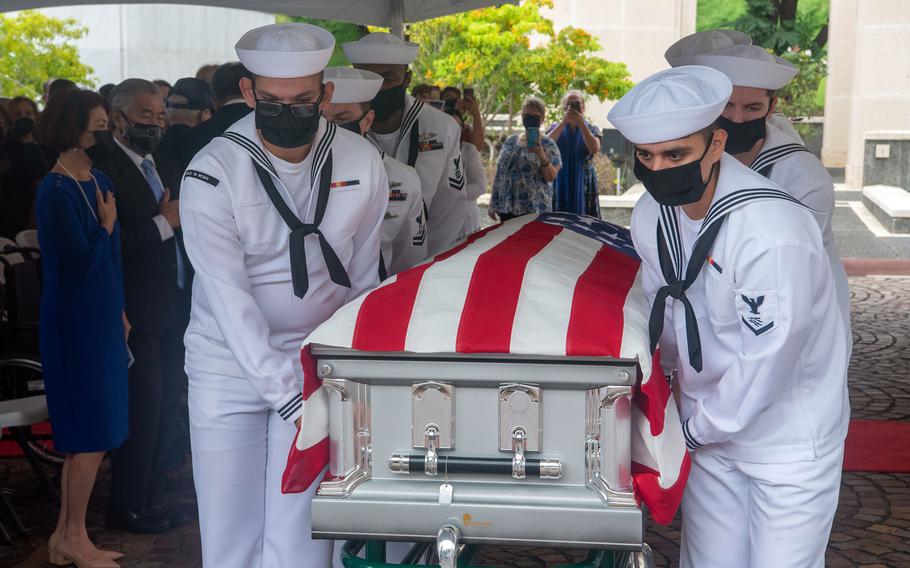
Sailors assigned to Navy Region Hawaii and the Defense POW/MIA Accounting Agency carry a casket during a USS Oklahoma reinterment ceremony at the National Memorial Cemetery of the Pacific in Honolulu, Hawaii, Dec. 7, 2021. (John Miller/Defense POW/MIA Accounting Agency)
FORT SHAFTER, Hawaii — The six-year project to identify the remains of unknown sailors and Marines who died aboard the USS Oklahoma during the Dec. 7, 1941, surprise attack on Oahu officially concluded Tuesday with the reburial of remains of 33 sailors that defied identification.
The Navy held a reinterment ceremony at the National Memorial Cemetery of the Pacific, also called the Punchbowl, in Honolulu, where the remains had originally been buried under gravestones marked unknown.
The remains were separated into four caskets, three of which were buried last week, and the final interred Tuesday, the 80th anniversary of Japan’s surprise attack on Pearl Harbor, Capt. Robert McMahon, head of Navy Casualty, said at a media roundtable Monday in Honolulu.
The ceremony was closed to the public. About 85 family members of sailors and Marines who had served on the Oklahoma attended the ceremony. David Russell, who was serving aboard the Oklahoma as a seaman first class on the day of the attack, also attended.
The Oklahoma was moored on Battleship Row when Japanese bombers descended on Pearl Harbor. Several made direct hits on the ship, capsizing it and killing 429 crew members.
After being moved to several gravesites, the remains of 394 sailors and Marines who died that day — all too badly burned, disfigured or decayed to identify — were laid to rest in 46 plots for the unknown in 1950. A few of those remains had been identified in the years leading up to 2015.
Kelly McKeague, director of the Defense POW/MIA Accounting Agency, said during the roundtable that completing the project was “difficult and challenging” almost as much as convincing Department of Defense officials “that this was the right thing to do.”
“Part of that has to do with culture; part of that has to do with the fact that some in the Department of Defense believe that preserving the sanctity of the grave was paramount,” McKeague said.
When the project began in 2015, 388 crew members were unaccounted for, Carrie LeGarde, the project’s lead anthropologist, said at the roundtable. The project identified 355 of them since that time, she said.
There was insufficient evidence to definitively associate any of the final 33 remains with the sailors who have never been accounted for, she said.
The remains were compartmentalized in the four caskets in case future advancements in DNA technology allow some or all to be identified, she said.